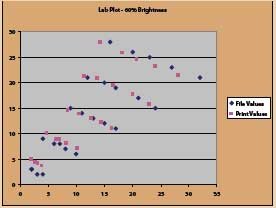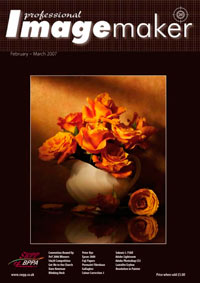articles/Paper/fujibarytecanvas-page5
Paper Chase - Fuji Film - Baryte Canvas HD and Museum Soft Papers - part 5 of 1 2 3 4 5 6
by Mike McNamee Published 01/02/2007
PermaJet Fibre Base Family
Nothing stays still for long - traditional look-alikes a year on and even better!
This trio are a selection from the PermaJet range which all carry the 'fibre' tag. They are Fibre Base Gloss, Fibre Base Gloss Warm Tone and Delta Matt Fibre. At Professional Imagemaker we have tested them before but some changes have been made to the base material of the Fibre Base Gloss (we refer to it as FBG325 for the moment) and none have been tested on the new Epson 3800. The baseline properties are tabulated opposite. Here is what we found in the detail.
Permajet Fibre Base Gloss (325)
This is 'nominally' the same fibre base 'lookalike' we have previously tested as a 295gsm media. It is, and remains, a favourite in all its guises, creating high Dmax, an extensive gamut and spectacularly good skin-tone accuracies.
However, one of our criticisms of this class of material has been the effect of the (desirable) stiffness on transport through Epson printers. We have experienced scuffing of the paper edges and misalignment at the back end of the print with papers from various makers on the 2400, 3800, 4800 and 7800 and wrote about it in the last issue. PermaJet have changed the make-up of their substrate material and provided a back coating to counteract the curling. Now we get the best of both worlds, the paper is stiff (and expensive feeling) and flat as a pancake! As far as we can tell this tactic has been successful and we did not experience any problems with the 325gsm media. On the 3800 we were able to load the media through the front (top) slot (but not the rearward slot). Using the front 'board' slot was not a success as the altitude of the heads is increased, leading to scattering of the ink alongside solid blocks of colour. An additional benefit of the new base media is an increase in the smoothness of the printed surface. The FBG325 is thus unique in the 'lookalikes'.

Saturation of the skin tones is maintained by the cream paper and also rotated a couple of degrees towards yellow to create very subtle tanning effect. Both portraitists and traditionalist monochrome workers are going to like this.
It is testament to just how good the modern ink, printer and paper systems have become that we have to go to evergreater lengths to differentiate the performance of papers. No longer is it possible to simply cast an eye over a set of prints, in reasonable lighting and pronounce on their merits. These days we have to carry out many hours of testing and measuring (we actually have our computer routines carry out over 6,000 calculations just to measure and plot the colour audit data). The testing of these three papers was a case in point. Things move on and the data we obtained for the Delta Matt were originally on the Epson 4000 with UltraChrome inks, the 295 FBG was tested (one year ago exactly) on the Epson 4800 using K3 UltraChrome inks and now we wanted to see if the 3800 Epson was lifting standards higher still (it was btw!).
Overall with the FBG325 and the Epson 3800 we squeezed the gamut volume to a new record high for this class of material at 880,760. The 3800 itself had raised the bar a little with Epson Premium Luster being lifted to 909,950 (see report in this issue). It would seem, therefore, that the Epson 3800 is driving up the values but that the FBG325 is exploiting them to the full! The Dmax of FBG325 was 2.29, almost identical to Epson Premium Luster or Premium Glossy Photo Paper. The average colour error measured at 4.6ΔELab/2.86ΔE2000 using perceptual rendering intent, and we got it down a little to 4.4ΔE Lab/2.47ΔE2000 using relative colourmetric rendering. These are tiny differences but it is nice to get below 2.5 ΔE2000 even if the eye is hard pressed to spot the difference! As with other testing, the skin tones are spectacularly accurate (2.4 ΔE Lab/2.1ΔE2000).
Fibre Base Gloss Warm Tone
At the moment, this media remains as the 295gsm variant and so the only new feature to our testing was the 3800. This is a slightly cream paper, which does not contain optical brighteners. This will make it attractive to the die-hard traditionalists who probably like both a warm paper and an absence of OBAs! A by-product of the warm base is even more accurate skin tones, which came in at 1.5ΔE Lab/1.7ΔE2000. This warming effect was detectable by eye when the prints were compared side by side, the skin tones were slightly more saturated and just a smidge warmer - a nice paper for the traditional portraitist as well then! For monochrome work if you like a warm print, reminiscent of a light thiocarbamide toner then this material does the business.
Please Note:
There is more than one page for this Article.
You are currently on page 5
- Paper Chase - Fuji Film - Baryte Canvas HD and Museum Soft Papers page 1
- Paper Chase - Fuji Film - Baryte Canvas HD and Museum Soft Papers page 2
- Paper Chase - Fuji Film - Baryte Canvas HD and Museum Soft Papers page 3
- Paper Chase - Fuji Film - Baryte Canvas HD and Museum Soft Papers page 4
- Paper Chase - Fuji Film - Baryte Canvas HD and Museum Soft Papers page 5
- Paper Chase - Fuji Film - Baryte Canvas HD and Museum Soft Papers page 6
1st Published 01/02/2007
last update 09/12/2022 14:54:30
More Paper Articles
There are 32 days to get ready for The Society of Photographers Convention and Trade Show at The Novotel London West, Hammersmith ...
which starts on Wednesday 14th January 2026





